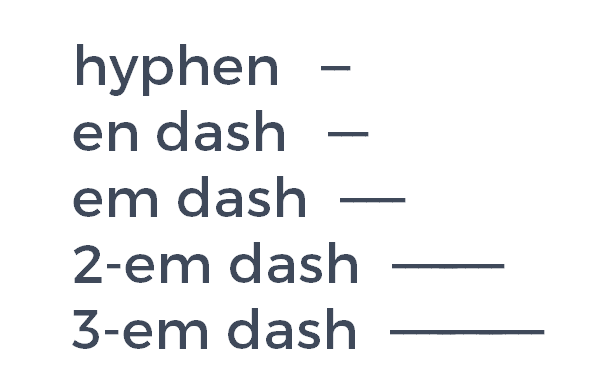What is a 2-Em Dash? (and When to Use It and How to Insert It)
Using dashes properly in formal writing shows a level of care and sophistication that many readers have come to expect.
Below, we’ll look at the 2-em dash (⸺).
What’s covered in this article
a quick refresher on dashes
the 2-em dash and how to use it, when to use a 2-em dash, some 2-em dash guidelines, and how to insert 2-em dashes
Dashes: A Quick Refresher
In an earlier article, I wrote about the en dash (–) and how to properly use it in formal writing with The Chicago Manual of Style as your style guide.
In another article, I explained the em dash (—).
The en dash (so named because it was traditionally the width of the letter n) connects the ends of a range (of numbers, dates, etc.), connects geographical locations or opposing things, and substitutes for a hyphen when connecting elements that are hyphenated or multi-word.
The em dash (so named because it was traditionally the width of the letter m) sets off text, indicates interruption or pause in speech, and appears before attributions of quoted material.
The 3-em dash (so named because it looks like three consecutive em dashes) is used in bibliographies to indicate an entry by the same author(s), editor(s), translator(s) as the previous entry.
The 2-em dash and how to use it
The 2-em dash—two consecutive em dashes—indicates missing or disguised letters or words.
It is sometimes called the omission dash or the double em dash.
Use the 2-em dash
to indicate a missing word or letters in a word
to indicate a whole word that is missing, illegible, or inaudible (with a space on either side of the 2-em dash)
to indicate missing, illegible, or inaudible names
to disguise a name (common in fiction and in old correspondence)
to “bleep out” a slur or an expletive (as an alternative to asterisks or symbols)
Put the polish on your manuscript.
Give it the proper punctuation, capitalization, and grammar it needs.
And make sure it’s clear, concise, and consistent. Aligned with Chicago Manual of Style guidelines. Something that’ll wow ’em.
Hire a copy editor—a Chicago Manual of Style editor.
Save yourself time, hassle, and potential embarrassment—and get a top-notch result.
Some guidelines for using the 2-em dash
When a whole word is missing, insert spaces on either side of the dash.
When part or parts of a word are missing, there should be no extra spacing before or after the dash. When the dash comes at the end of a word, insert a space after it, unless there is punctuation immediately following it.
Do not use underscore symbols, hyphens, or minus symbols in place of a 2-em dash.
If possible, use a 2-em dash symbol—not two consecutive em dashes—to avoid unwanted spacing that might appear in some fonts.
How to insert 2-em dashes
Use multiple em dashes
You can use two em dashes. Some fonts will leave space between each dash.
Copy and paste or insert the distinct character
There is a distinct 2-em dash character that can be copied and pasted, but not all fonts support it.
In MS Word on a desktop PC, type 2e3a Alt x [type 2e3a then hold down Alt and x].
If you can see it on your browser, copy and paste this 2-em dash:
⸺
Google Docs
Select Insert, Special Characters. Search for “dash” and find and select the em dash. Use it twice for a 2-em dash or select the 2-em dash character.
HTML
2-em dash: type ⸺ or ⸺
If you’re ready for copy editing to get your en dashes and em dashes right, send me a message. I’d love to help you.
Related articles:
the en dash (–)
the em dash (—)
the 3-em dash (⸻)
Get the “Get ready to self-publish” checklist, geared toward American authors
Happy revising,


